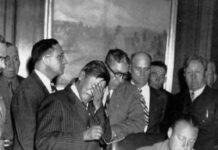Faced with an Aztec revolt against their rule, forces under the Spanish conquistador, Hernán Cortés fight their way out of Tenochtitlan at a heavy cost. Known to the Spanish as La Noche Triste, or “the Night of Sadness,” many soldiers drowned in Lake Texcoco when the vessel carrying them and Aztec treasures hoarded by Cortés sank. Montezuma II, the Aztec emperor who had become merely a subject of Cortés in the previous year, was also killed during the struggle; by the Aztecs or the Spanish, it is not known.
Tenochtitlan was founded in 1325 A.D. by a wandering tribe of hunters and gatherers on islands in Lake Texcoco, near the present site of Mexico City. In only one century, this civilization grew into the Aztec Empire, due largely to its advanced system of agriculture.
The empire came to dominate central Mexico and by the ascendance of Montezuma II in 1502 had reached its greatest extent, reaching as far south as perhaps modern-day Nicaragua. At the time, the empire was held together primarily by Aztec military strength, and Montezuma II set about establishing a bureaucracy, creating provinces that would pay tribute to the imperial capital of Tenochtitlan. The conquered peoples resented the Aztec demands for tribute and victims for the religious sacrifices, but the Aztec military kept rebellion at bay.
Meanwhile, Hernán Cortés, a young Spanish-born noble, came to Hispaniola in the West Indies in 1504. In 1511, he sailed with Diego Velazquez to conquer Cuba and twice was elected mayor of Santiago, the capital of Hispaniola.
In 1518, he was appointed captain-general of a new Spanish expedition to the American mainland. Velazquez, the governor of Cuba, later rescinded the order, and Cortés sailed without permission. He visited the coast of Yucatan and in March 1519 landed at Tabasco in Mexico’s Bay of Campeche with 500 soldiers, 100 sailors, and 16 horses. There, he won over the locals and was given an enslaved woman, Malinche—baptized Marina—who later bore him a son. She knew both Maya and Aztec and served as an interpreter.
The expedition then proceeded up the Mexican coast, where Cortes founded Veracruz, mainly for the purpose of having himself elected captain-general by the colony, thus shaking off the authority of Velazquez and making him responsible only to King Charles V of Spain.
At Veracruz, Cortés trained his army and then burned his ships to ensure loyalty to his plans for conquest. Having learned of political strife in the Aztec Empire, Cortés led his force into the Mexican interior. On the way to Tenochtitlan, he clashed with locals, but many of these peoples, including the nation of Tlaxcala, became his allies after learning of his plan to conquer their hated Aztec rulers.
Hearing of the approach of Cortes, with his frightful horses and sophisticated weapons, Montezuma II tried to buy him off, but Cortes would not be dissuaded. On November 8, 1519, the Spaniards and their 1,000 Tlaxcaltec warriors were allowed to enter Tenochtitlan unopposed.
Montezuma suspected them to be divine envoys of the god Quetzalcoatl, who was prophesied to return from the east in a “One Reed” year, which 1519 was on the Aztec calendar. The Spaniards were greeted with great honour, and Cortés seized the opportunity, taking Montezuma hostage so that he might govern the empire through him. His mistress, Marina, was a great help in this endeavour and succeeded in convincing Montezuma to cooperate fully.
In the spring of 1520, Cortés learned of the arrival of a Spanish force from Cuba, led by Panfilo Narvaez and sent by Velazquez to deprive Cortés of his command. Cortés led his army out of Tenochtitlan to meet them, leaving behind a garrison of 80 Spaniards and a few hundred Tlaxcaltecs to govern the city.
Cortés defeated Narvaez and enlisted Narvaez’ army into his own. When he returned to Tenochtitlan in June, he found the garrison under siege from the Aztecs, who had rebelled after the subordinate that Cortés left in command of the city massacred several Aztec chiefs and the population on the brink of revolt.
On June 30, under pressure and lacking food, Cortés and his men fled the capital at night. In the fighting that ensued, Montezuma was killed—in Aztec reports by the Spaniards, and in Spanish reports by an Aztec mob bitter at Montezuma’s subservience to Spanish rule. He was succeeded as emperor by his brother, Cuitlahuac.
During the Spaniards’ retreat, they defeated a large Aztec army at Otumba and then rejoined their Tlaxcaltec allies. In May 1521, Cortés returned to Tenochtitlan, and after a three-month siege, the city fell. This victory marked the fall of the Aztec empire. Cuauhtemoc, Cuitlahuac’s successor as emperor, was taken prisoner and later executed, and Cortés became the ruler of the vast Mexican empire.
The Spanish conquistador led an expedition to Honduras in 1524 and in 1528 returned to Spain to see the king. Charles made him Marques del Valle but refused to name him governor because of his quarrels with Velazquez and others.
In 1530, he returned to Mexico, now known as New Spain, and found the country in disarray. After restoring some order, he retired to his estate south of Mexico City and sent out maritime expeditions from the Pacific coast. In 1540, he returned to Spain and was neglected by the court. He died in 1547.
Follow the Neptune Prime channel on WhatsApp:
Do you have breaking news, interview request, opinion, suggestion, or want your event covered? Email us at neptuneprime2233@gmail.com





